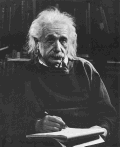Stephen Hawking has claimed victory in a bet with a fellow scientist over the discovery of primordial gravitational waves, ripples in the structure of space-time from the birth of the universe.
The Cambridge cosmologist bet Neil Turok, director of the Perimeter Institute in Canada, that gravitational waves from the first fleeting moments after the big bang would be detected.
Speaking on BBC Radio 4's Today programme, Hawking said the discovery of gravitational waves, announced on Monday by researchers at the Harvard-Smithsonian Centre for Astrophysics, disproves Turok's theory that the universe cycles endlessly from one big bang to another.
If confirmed by other groups, the discovery would count as the strongest evidence yet for cosmic inflation, a theory which says that the universe went through a period of extremely rapid expansion soon after the big bang. The theory explains why the universe looks almost the same in every direction.
"It is another confirmation of inflation," Hawking told the Today programme. "It also means I win a bet with Neil Turok, director of the Perimeter Institute in Canada, for cyclic universe theory predicts no gravitational waves from the early universe."
But Turok was not ready to concede just yet. He told the programme that the bet rested on results from the European Space Agency's Planck space telescope, which last year failed to spot any signs of gravitational waves.
"In 2001, I gave a talk proposing a new theory of the big bang according to which the big bang was just the latest in an infinite series of big bangs, and the universe would be a cyclic universe," Turok said. "Stephen, in typical fashion, at the end of a talk, said 'I bet you that the Planck satellite will discover the gravitational wave signal of inflation, which would immediately disprove your theory', because our prediction from our theory was that there would be no gravitational wave signal."
"So, of course, the Planck satellite flew, and last year announced its results, and there was no gravitational wave signal, so thus far, I'm winning the bet," he added.
The idea of cosmic inflation came to Alan Guth, a physicist at MIT, by chance one evening in 1979. He was up late in his apartment, working with pen and notebook, hoping to understand why the universe was not filled with strange particles called magnetic monopoles. He worked out that the universe would have far fewer of the particles if it went through a rapid period of supercooling. As he worked through the equations, one step stood out. It suggested that the expansion of the early universe would be exponential.
Over the next three decades, scientists, including Andrei Linde at Stanford University, developed the theory into its modern form. In 1982, Hawking added to the work with a paper that suggested galaxies arose from tiny irregularities in the early universe.
"This paper aroused interest among other scientists who had been thinking on similar lines, so I invited them all to a workshop in Cambridge in June 1982 supported by the Nuffield Foundation. At the workshop we established the now accepted picture of inflation in the very early universe, although it was not confirmed by observation until 10 years later," Hawking told Today.
Turok urged caution over the latest claims. "First of all, I should say this is just a spectacular result, and right or wrong, it actually indicates we are right on the threshold of a completely new window into the big bang and what happened at the big bang, so it's tremendously exciting," he said.
But he added: "I have reasons for doubts about the new experiment and its results. It's not entirely convincing to me, but they have clearly seen what they claim to have seen. Verification is very important and it's wise to be a little bit sceptical at the moment when there is no confirmation. The experiment was extremely difficult, and they don't entirely explain why they are so convinced of what they claim … The problem with the inflationary theory is that it really doesn't explain the beginning. Stephen has postulated a way of starting the universe off, but it doesn't seem to work."
Hawking is well known for making bets with other scientists. He recently lost $100 to Gordon Kane at the University of Michigan after betting that scientists at Cern, home of the Large Hadron Collider near Geneva, would not find the Higgs boson. They discovered the particle in July 2012.
Turok said he needed to see more evidence for gravitational waves from the big bang before conceding the bet to Hawking. "The great thing about science is that it doesn't matter how many [scientists] you are up against. Ultimately the right ideas win out. Science is not a popularity contest. Galileo was right, but his ideas weren't popular at the time. The bet is still open," he said.
• This article was amended on 18 March 2014. The original described Neil Turok as a Canadian physicist. This has been corrected.

